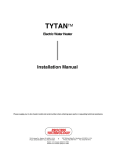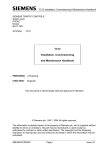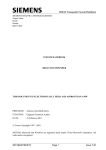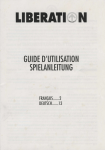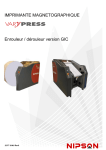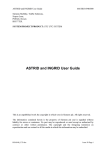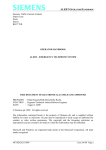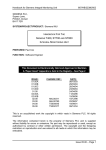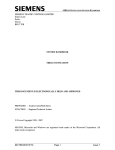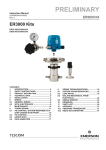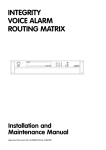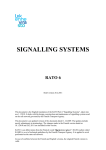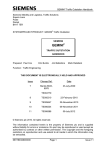Download Siemens TC12 User guide
Transcript
TC12 General Handbook SIEMENS TRAFFIC CONTROLS, Sopers Lane, POOLE, Dorset. BH17 7ER. SYSTEM: TC12 TC12 General Handbook PREPARED: A Pickering FUNCTION: Engineer This document is electronically held and approved ISSUE: 1 2 3 4 5 6 7 8 9 REF: DATE: TS003024 19/12/92 19/01/93 05/05/93 28/04/94 08/05/97 26/01/99 20/06/00 09/01/02 13/01/2006 © Siemens plc. 2002 All rights reserved. The information contained herein is the property of Siemens plc. and is supplied without liability for errors or omissions. No part may be reproduced or used except as authorized by contract or other written permission. The copyright and the foregoing restriction on reproduction and use extend to all media in which the information may be embodied. 666/HB/43100/000 Page i Issue 9 TC12 General Handbook ISSUE STATE Note :- Source of documents is shown under Type as below. 1=Paper, 2=VAX, 3=Microfilm, 4=CALTEXT Disc, 5=DECmate Disc, 6=Paper Insert, 7=MAC Disc, 8=LIFESPAN, 9=SUN, 10=Meridian The document comprises the following components :- Pages Current Issue Type Part ID i to viii 9 10 666/HB/43100/000 1-1 9 10 666/HB/43100/000 2-1 to 2-4 9 10 666/HB/43100/000 3-1 9 10 666/HB/43100/000 4-1 to 4-7 9 10 666/HB/43100/000 5-1 to 5-18 9 10 666/HB/43100/000 6-1 9 10 666/HB/43100/000 Insert the following documents / drawings at the end of this document, use the latest issue available. DRAWINGS TO BE A3 - DOCUMENTS AT A4. 666/HE/43100/000 AND ALL DRAWINGS/DOCUMENTS ASSOCIATED WITH IT. 666/HB/43100/000 Page ii Issue 9 TC12 General Handbook SAFETY WARNING In the interests of health and safety, when using or servicing this equipment the following instructions must be noted and adhered to: i. Only skilled or instructed personnel with relevant technical knowledge and experience, who are also familiar with the safety procedures required when dealing with modern electrical/electronic equipment are to be allowed to use and/or work on the equipment. All work shall be performed in accordance with the Electricity at Work Regulations 1989. ii. Such personnel must take heed of all relevant notes, cautions and warnings in this handbook, the General Handbook (666/HB/43100/000) and any other document or handbook associated with the equipment. (a) The equipment must be correctly connected to the specified incoming power supply. (b) The equipment must be disconnected/isolated from the incoming power supply before removing protective covers or working on any part from which protective covers have been removed. 666/HB/43100/000 Page iii Issue 9 TC12 General Handbook TELECOMMUNICATIONS APPROVAL WARNING The TC12 Modems 667/1/22669/000, 667/1/22668/000 and 667/1/22668/001 and the TC12 OTU/LMU PCB Assemblies 666/1/02262/001 and 666/1/02262/021 are Approved for connection to British Telecommunications Private Circuits in a Multipoint or Point to Point configuration as defined in BS6328: Part 1: 1982, subject to the conditions set out in the instructions for use. TC12 Modems Approval Number: NS/1143/2/N/603301 Date: 18/8/92 TC12 OTU/LMU PCB Approval Number: NS/1143/2/N/603385 Date: 10/11/92 The Modem apparatus is intended for use when supplied with power from a source with the following characteristics: +5V (700mA), +12V (110mA) and -12V (160mA). Ensure that the power drawn by this modem together with any other auxiliary apparatus drawing power from the host, lies within the rating of the host power supply. The OTU/LMU is intended for use when supplied with power from a source with the following characteristics: +5V (2.2A), +24V (250mA). Ensure that the power drawn by the OTU/LMU together with any other auxiliary apparatus drawing power from the host, lies within the rating of the host power supply. Other usage will invalidate any approval given to this apparatus if as a result it ceases to comply with BS6301: 1989. This apparatus is NOT suitable for connection to the PSTN or to circuits with British Telecommunications signalling at a nominal frequency of 2280Hz. It is not intended that there shall be any d.c. interaction between this apparatus and British Telecommunications private circuits, nor does this apparatus use the frequency range d.c. to 200Hz. The approval of this apparatus for connection to British Telecommunication Private Speechband circuits is INVALIDATED if the apparatus is subject to any modification in any material way not authorized by BABT or its use with, or connected to :(i) internal software that has not been formally accepted by BABT. (ii) external control software or external control apparatus which causes the operation of the modem or associated call set-up equipment to contravene the requirements of the standard set out in BABT/SITS/82/01/C. All apparatus connected to this modem and thereby connected directly or indirectly to British Telecommunication Private Speechband circuits must be approved apparatus defined in Section 16 of the British Telecommunication Act 1981. The TC12 Instation 667/1/22600/ETC is covered by the General Approval for indirect connection of apparatus under Section 22 of the 1984 Telecommunications Act, Approval no. NS/G/1234/J/100003. The mark of approval for the TC12 modem must NOT be applied to the Instation as a whole. TheTC12 Freestanding OTU/LMU 667/1/22670/ETC is covered by the General Approval for indirect connection of apparatus under Section 22 of the 1984 Telecommunications Act, Approval no. NS/G/1234/J/100003. The mark of approval for the TC12 OTU/LMU PCB Assembly must NOT be applied to the TC12 Freestanding OTU/LMU mechanics as a whole. This Handbook must be supplied with the apparatus. Validity of the approval depends on this information being supplied including the User Guide in the General Handbook 666/HB/43100/000. 666/HB/43100/000 Page iv Issue 9 TC12 General Handbook PREFACE It is intended that this preface should guide the reader as to the use of this handbook, thus assisting the reader in selecting the best section to read in order to obtain the information required. Section 1 Introduction:- An introduction to both the handbook and the TC12 system. Section 2 Specification:- This gives values and ranges for the following items: Weight, Size, Currents, Voltages, etc. Section 3 Modem User Guide. Section 4 System Hardware:- A basic description of the hardware used in TC12. Section 5 System Facilities:- A complete list of the facilities provided by a TC12 system. Section 6 Integral OTU. 666/HB/43100/000 Page v Issue 9 TC12 General Handbook TABLE OF CONTENTS 1. INTRODUCTION ............................................................................................................................ 1-1 1.1 1.2 1.3 1.4 2. Purpose....................................................................................................................................... 1-1 Related documents ..................................................................................................................... 1-1 Definitions ................................................................................................................................... 1-1 Summary of Major Changes ....................................................................................................... 1-1 SPECIFICATION ............................................................................................................................ 2-1 2.1 Mains Voltage Ranges................................................................................................................ 2-1 2.2 Mains frequency range ............................................................................................................... 2-1 2.3 Mains Current ............................................................................................................................. 2-1 2.3.1 Instation ............................................................................................................................... 2-1 2.3.2 Outstation............................................................................................................................. 2-1 2.3.3 Test Sets.............................................................................................................................. 2-1 2.4 Temperature and Humidity Requirements.................................................................................. 2-1 2.5 Size and Weight.......................................................................................................................... 2-2 2.5.1 Instation ............................................................................................................................... 2-2 2.5.2 Outstation............................................................................................................................. 2-2 2.5.3 Instation Test Set................................................................................................................. 2-2 2.5.4 Outstation Test Set .............................................................................................................. 2-2 2.6 Approvals .................................................................................................................................... 2-2 2.6.1 British Telecom .................................................................................................................... 2-2 2.6.2 Department of Transport...................................................................................................... 2-2 2.6.3 Other Approvals................................................................................................................... 2-2 2.7 General Overview ....................................................................................................................... 2-3 3. MODEM USERS GUIDE ................................................................................................................ 3-1 4. SYSTEM HARDWARE................................................................................................................... 4-1 4.1 General ....................................................................................................................................... 4-1 4.2 UTC Traffic Control Computer System ....................................................................................... 4-1 4.3 Instation....................................................................................................................................... 4-1 4.4 Test Sets ..................................................................................................................................... 4-2 4.4.1 Instation Test Set................................................................................................................. 4-2 4.4.2 Outstation Test Set .............................................................................................................. 4-2 4.5 Freestanding Outstation.............................................................................................................. 4-2 5. SYSTEM FACILITIES..................................................................................................................... 5-1 5.1 General System .......................................................................................................................... 5-1 5.1.1 Baud Rate ............................................................................................................................ 5-1 5.1.2 Modem Signal Levels .......................................................................................................... 5-1 5.1.3 Connection to Leased Telephone Line................................................................................ 5-1 5.1.4 Number of OTUs per Line ................................................................................................... 5-2 5.2 Instation Facilities ..................................................................................................................... 5-11 5.2.1 The System Fault Indication Panel.................................................................................... 5-11 5.2.2 Modem fault indication....................................................................................................... 5-11 5.2.3 Fault Actions ...................................................................................................................... 5-11 5.2.4 PSTN Modem .................................................................................................................... 5-11 5.2.5 TC8 Integration .................................................................................................................. 5-11 5.2.6 Digital Output Facilities ...................................................................................................... 5-11 5.3 Free-standing Outstation Facilities ........................................................................................... 5-13 5.3.1 Handset.............................................................................................................................. 5-13 5.3.2 OTU Inputs and Outputs.................................................................................................... 5-13 5.3.3 Indicators ........................................................................................................................... 5-13 5.3.4 Fault Action ........................................................................................................................ 5-13 5.3.5 Remote Controller Handset ............................................................................................... 5-13 5.3.6 Instation Communications Method .................................................................................... 5-14 666/HB/43100/000 Page vi Issue 9 TC12 General Handbook 5.4 Lamp Monitoring Facilities ........................................................................................................ 5-14 5.4.1 General .............................................................................................................................. 5-14 5.4.2 Red Lamp Monitoring ........................................................................................................ 5-15 5.5 Detector Fault Monitoring (DFM) .............................................................................................. 5-15 5.6 High Occupancy Software (HIOCC) ......................................................................................... 5-16 5.6.1 General .............................................................................................................................. 5-16 5.6.2 Hardware ........................................................................................................................... 5-16 5.6.3 Software............................................................................................................................. 5-16 5.6.4 Configurable options.......................................................................................................... 5-17 5.6.5 Instation Test Set............................................................................................................... 5-17 5.6.6 Monitor Mode ..................................................................................................................... 5-17 5.6.7 Instation Mode ................................................................................................................... 5-17 5.6.8 Outstation Mode ................................................................................................................ 5-18 5.6.9 Data Displayed by the ITS ................................................................................................. 5-18 5.6.10 Idle Condition ..................................................................................................................... 5-18 5.7 Outstation Test Set ................................................................................................................... 5-18 6. INTEGRAL OUTSTATION TRANSMISSION UNIT (OTU) ............................................................ 6-1 6.1 6.2 6.3 General Overview ....................................................................................................................... 6-1 Indicators..................................................................................................................................... 6-1 Fault Action ................................................................................................................................. 6-1 FIGURES Figure 1 - OVERVIEW OF TC12 SYSTEM ............................................................................................... 2-4 Figure 2 - INSTATION CABINET .............................................................................................................. 4-3 Figure 3 - ITU RACK ................................................................................................................................. 4-4 Figure 4 - DIGITAL OUTPUT RACK ......................................................................................................... 4-5 Figure 5 - OTU RACK................................................................................................................................ 4-5 Figure 6 - INSTATION TEST SET............................................................................................................. 4-6 Figure 7 - OUTSTATION TEST SET......................................................................................................... 4-7 Figure 8 - MESSAGE FORMAT - FULL AND HALF DUPLEX ................................................................. 5-3 Figure 9 - INSTATION SYSTEM ............................................................................................................. 5-12 TABLES Table 1 - MODEM CAPACITY .................................................................................................................. 5-4 Table 2 - OTUS PER LINE (1200 BAUD FULL DUPLEX) ........................................................................ 5-5 Table 3 - OTUS PER LINE (1200 BAUD HALF DUPLEX) ....................................................................... 5-6 Table 4 - OTUS PER LINE (600 BAUD FULL DUPLEX) .......................................................................... 5-7 Table 5 - OTUS PER LINE (600 BAUD HALF DUPLEX) ......................................................................... 5-8 Table 6 - OTUS PER LINE (300 BAUD FULL DUPLEX) .......................................................................... 5-9 Table 7 - OTUS PER LINE (300 BAUD HALF DUPLEX) ....................................................................... 5-10 666/HB/43100/000 Page vii Issue 9 TC12 General Handbook 1. INTRODUCTION 1.1 Purpose This document describes to the user the TC12 Traffic Control Data Transmission System, which consists of an Instation, an Outstation, an Instation Test Set and an Outstation Test Set. 1.2 Related documents 666/HE/43100/000 TC12 Installation, Commissioning and Maintenance Handbook. 1.3 Definitions BABT BT DFM DSP IMD I/O ITU ITS OTU OTS PC PSTN RAM RLM SCOOT TCC UTC British Approvals Board for Telecommunications British Telecom Detector Fault Monitoring Digital Signal Processor Intelligent Modem Driver Input/Output Instation Transmission Unit Instation Test Set Outstation Transmission Unit Outstation Test Set Personal Computer Public Switched Telephone Network Random Access Memory Red Lamp Monitoring Split Cycle Offset Optimisation Technique Traffic Control Computer Urban Traffic Control 1.4 Summary of Major Changes OTU / Instation RS232 communications added . 666/HB/43100/000 Page 1-1 Issue 9 TC12 General Handbook 2. SPECIFICATION 2.1 Mains Voltage Ranges Instation 98 - 132Vrms / 198 - 264Vrms Outstation 85 - 264Vrms Instation Test Set 98 - 132Vrms / 198 - 264Vrms Outstation Test Set 99 - 121Vrms / 216 - 264Vrms 2.2 Mains frequency range All TC12 equipment will work from 47Hz to 63Hz. 2.3 Mains Current 2.3.1 Instation Instation Cabinet without racks 1.0A at 240V ITU Rack (Fully equipped) 200mA at 240V Digital Output Rack (Fully equipped) 1024 LEDs at 24V 25mA per LED 4.5A at 240V Digital Output Rack (Fully equipped) 1024 LEDs at 24V 15mA per LED 2.75A at 240V The figures above are added together for the system used: An Instation cabinet with two ITU racks 1.0 + 0.2 + 0.2 = 1.4A An Instation cabinet with two 15mA Digital output racks 1.0 + 2.75 + 2.75 = 6.50A 2.3.2 Outstation OTU rack including 4 Detector cards 250mA at 240V 2.3.3 Test Sets Instation Test Set 400mA at 240V Outstation Test Set 100mA at 240V 2.4 Temperature and Humidity Requirements Instation will work at 0 to 40 Deg C. Humidity 20%-80% non-condensing. OTU will work at -15 to 75 Deg C. Humidity 96% at 40 Deg C non condensing. 666/HB/43100/000 Page 2-1 Issue 9 TC12 General Handbook 2.5 Size and Weight 2.5.1 Instation Height Width Depth 1601mm 600mm 800mm Cabinet ITU Rack Digital Output Rack 111Kg 8.4Kg 8.3Kg NOTE : The weight of the cabinet does not include any of the PC equipment, and the weights specified for the racks are with their full complement of PCBs. 2.5.2 Outstation Height Width Depth Weight 222.3mm 482.6mm 305.0mm 5.4Kg NOTE: The weight of the OTU does not include detectors or their backplanes. 2.5.3 Instation Test Set Height Width Depth Weight 530mm 354mm 215mm 13Kg 2.5.4 Outstation Test Set Height Width Depth Weight 191mm 330mm 229mm 6Kg 2.6 Approvals 2.6.1 British Telecom The TC12 Instation and Outstation are covered by BABT approval for connection to British Telecommunications private circuits. 2.6.2 Department of Transport The TC12 System is approved to DTp Specification MCE0361. 2.6.3 Other Approvals As required by the appropriate authorities for the numerous countries where the system may be installed and shall only be obtained as part of a contract requirement. 666/HB/43100/000 Page 2-2 Issue 9 TC12 General Handbook 2.7 General Overview TC12 is a telecommunications system designed for Urban Traffic Control (UTC). It consists of a number of Outstation Transmission Units (OTUs) positioned in traffic controller or detector cabinets. The OTUs communicate with a Central Office containing one or more Instations. Communication between the OTU and an Instation is by means of a) telephone (normally leased) lines, which can be operated at different baud rates and signal levels or b) RS232 serial links which can be operated at the same baud rates as the telephone lines. The Instation periodically sends a Control message to the OTU which will cause the OTU to form the appropriate Reply message which it will send back. These messages are of configurable size depending on the amount of data transfer needed. The Instation connects via an ethernet link to a Traffic Control Computer (TCC) system consisting of one or more computers. This system drives the Instation modems, which communicate with the OTU via the telephone lines. The modems are not provided where RS232 serial links are required. The Instation also drives the System Fault Indication Panel (SIP) which indicates, by means of LEDs and an audible alarm, failures in the TCC. The SIP is housed in the Instation cabinet but there is also the option of driving a remote SIP. The TC12 Instation can also be used to drive a TC8 instation. There is also facility for an Instation Test Set which can be used to measure signal levels and monitor communications (both data and errors) on the telephone lines. It can also be used to take the place of either Instation or Outstation for testing. The Outstation test set is used in place of the controller to both set Reply bits and monitor Control bits at the OTU. See Figure 1 for a TC12 system overview. 666/HB/43100/000 Page 2-3 Issue 9 TC12 General Handbook Figure 1 - OVERVIEW OF TC12 SYSTEM UTC TCC Ethernet Instation Cabinet To optional extra UTC TCCs PC To TC8 V.24 SIP INSTATION ITU To Remote SIP Telephone lines / RS232 OTU OUTSTATION I/O (Loops etc) CONTROLLER 666/HB/43100/000 Page 2-4 Issue 9 TC12 General Handbook 3. MODEM USERS GUIDE The Modems installed in the Instation cabinet have been installed and commissioned by professional personnel. The user should not attempt to alter any of the settings on the Modem PCBs. Any changes not carried out by authorized professional personnel may not only invalidate the BABT Approval but lead to degradation of performance. 666/HB/43100/000 Page 3-1 Issue 9 TC12 General Handbook 4. SYSTEM HARDWARE 4.1 General The TC12 system comprises of the following equipment : UTC Traffic Control Computer (TCC) - see 4.2. Instation - see 4.3. Outstation Instation Test Set Outstation Test Set. See Figure 1 for an overview of the TC12 System. 4.2 UTC Traffic Control Computer System The UTC Traffic Control Computer is either a VAX of Alpha system containing a minimum of one computer. The TCC communicates with the instation PC(s) via an ethernet link. Individual computers within the TCC communicate with each other via an ethernet link. 4.3 Instation 4.3.1.1 General The Instation comprises of a cabinet containing a single communications PC and one or more racks of equipment. The instation cabinet is 32U high with grey panelling and a smoked glass front door. The instation cabinet is fitted with the PC at the top, with space for up to four racks below it. If the PC does not house an integral RS232 serial fan-out card, the rack immediately below the PC will be fitted with a 16-way RS232 serial fan-out unit, otherwise this rack will be either an Instation Transmission Unit (ITU) rack or a Digital Output rack. The racks below the top rack will be either ITU or Digital Output racks, but the bottom rack can be used for an OTU if required. There is also a mains distribution system with spare sockets, and facility for mounting a PSTN modem which would connect to the TCC to allow remote interrogation. See Figure 2. 4.3.1.2 System Fault Indication Panel The System Fault Indication Panel (SIP) is positioned in front of the PC and houses LEDs to warn of various failures. There is also an audible alarm on the SIP which can be cancelled by a switch next to it or disabled by a switch on the PSU board. 4.3.1.3 ITU Rack A fully equipped ITU rack contains three types of board consisting of four modem boards, four transformer boards and a PSU board. The modem board has four modem chips or a DSP chip on a daugher board which communicate with the PC via an RS232 link. These modems are connected to the OTU via the telephone lines in either radial, multidrop or multipoint format - see 5.1.3. There is also a pair of test jacks on the modem board to allow connection to the instation test set to monitor communications data and measure signal levels. To connect the OTU in radial format a Radial Modem assembly is required. This comprises of the standard Modem PCB plus a Transformer PCB. 666/HB/43100/000 Page 4-1 Issue 9 TC12 General Handbook The transformer board is used, when the system is in radial configuration, to split each modem to up to 8 telephone lines. This gives a maximum of 128 telephone lines per rack. The PSU board supplies power to the ITU rack. It also interfaces between the PC and the SIP and allows connection to a TC8 ITU rack. This facility would be used should a TC8 system be expanded with TC12. See Figure 3. 4.3.1.4 Digital Output Rack The Digital output rack contains one instation rack Power Supply Card and between one and sixteen Digital Output boards, each capable of driving 64 LEDs at up to 30V 25mA. There are two variants of Digital Output board, one sources current and the other sinks current. The system could be used for any application requiring digital output, not just wallmap driving. See Figure 5. 4.4 Test Sets There are two test sets used with the TC12 System, an Instation test set and an Outstation test set. 4.4.1 Instation Test Set The Instation Test Set (ITS) is housed in an attaché case, and connects to either the Modem pcbs or the OTU pcbs. Facilities are also provided for use as a handset terminal or for use as a monitor for the Instation PC (during installation and maintenance). See Figure 6. 4.4.2 Outstation Test Set The Outstation test set is a portable unit housed in a small grey metal case. It requires a mains supply for operation and two cable forms with which to interface with the OTU being tested. See Figure 7. 4.5 Freestanding Outstation The freestanding outstation is a rack which can be bolted into any Traffic Controller. It contains a Power Supply, an OTU PCB and up to four detector PCBs. Two connectors allow the OTU inputs and outputs to be wired up to the controller and / or detector cards. The OTU is delivered with a cable for this purpose. There is also a pair of test jacks on the board to allow connection to the instation test set to monitor communications data and measure signal levels when communications is via telephone lines. See Figure 5. The OTU PCB may be equipped with a daughter board to allow RS232 communications with the Instation. 666/HB/43100/000 Page 4-2 Issue 9 TC12 General Handbook Figure 2 - INSTATION CABINET System Fault Indication Panel PC Housed behind SIP ITU or Digital Output Rack ITU or Digital Output Rack Blanking Panel OTU if required Mains Distribution and Sockets 666/HB/43100/000 Page 4-3 Issue 9 TC12 General Handbook Figure 3 - ITU RACK 6U Rack PSU M O D E M 1 T R A N S R 1 M O D E M 2 T R A N S R 2 M O D E M 3 T R A N S R 3 M O D E M 4 T R A N S R 4 1.5” 666/HB/43100/000 Page 4-4 Issue 9 TC12 General Handbook Figure 4 - DIGITAL OUTPUT RACK 6U Rack PSU Digital Output PCBs Figure 5 - OTU RACK 5U Rack Handset Port Status LEDs Test Set Jack Sockets PSU 3U Space for Detectors Single PCB OTU Telephone Socket NOTE : A double OTU is available in 19” rack mounting. This comprises of 2 OTU PCBs sharing the same power supply. The amount of 3U space for detectors is reduced to allow fitting in a 19” rack. 666/HB/43100/000 Page 4-5 Issue 9 TC12 General Handbook Figure 6 - INSTATION TEST SET Case Lid OFF Mains In ON FUSE Modem Set Modem Mode TC12 Jack Connections PC Carrier Detect Level Handset Space for Cables & Headphones Test Set Attenuator 666/HB/43100/000 Page 4-6 Handset Issue 9 TC12 General Handbook Figure 7 - OUTSTATION TEST SET LEDs Case Lid OUTSTATION TEST SET OFF CONNECT TO CONTROLLER ONLY ON CONNECT TO OTU ONLY 7 6 5 4 3 2 1 Trans Confirm 0 FUSE Modem Set Modem Mode 15 14 13 12 11 10 9 Connection Fault 8 WORD 2 ONLY Carrier Detect Level Mode Lamp Test OTU OFF 1 Word Space for CONTROLLER Mains Cable Handset 2 Word Test Set FUSE MAINS Attenuator Handset POCKET FOR CABLES SWITCHES 666/HB/43100/000 CONNECTION TO OTU Page 4-7 Issue 9 TC12 General Handbook 5. SYSTEM FACILITIES Each Instation can contain up to 4 racks of TC12 equipment. These can be either ITU racks for communication or Digital Output racks for wallmap driving. An ITU rack can contain up to 4 modem boards, each of which contains 4 modems capable of driving a 2 or 4 wire telephone line. Each telephone line supports one or more OTUs depending on the line configuration - see 5.1.4. A transformer board can be included with each modem board, in the ITU rack, to allow the 4 modems on a board to drive eight 2-wire radial telephone lines. The Instation can also be set up to communicate with suitably equipped OTUs via direct RS232 serial links instead of telephone lines. 5.1 General System 5.1.1 Baud Rate TC12 operates at 300, 600 and 1200 bits per second in full or half duplex mode. Communications over telephone lines is in either two or four wire mode (full duplex may only be used in 4-wire mode). 5.1.2 Modem Signal Levels 5.1.2.1 Transmit The modem transmit signals can be set to the following levels at both the instation and outstation: 0dBm -3dBm -6dBm -9dBm -10dBm -13dBm -16dBm 5.1.2.2 Receive The modem receive line levels are set up by switch settings on both the ITU and OTU. They can be set so that the minimum signal level registered by the modem is either -33dBm, -39dBm or -42dBm. 5.1.3 Connection to Leased Telephone Line 5.1.3.1 BT Lines for use with TC12 Systems (a) For Point to Point circuits:Keyline 3, option 1 - Two wire presentation Keyline 3, option 2 - Four wire presentation Or Analogue Standard ( Data) – Either Two or Four wire presentation Keyline 3, option 3 - Two wire presentation, better quality Keyline 3, option 4 - Four wire presentation, better quality Or Analogue Premier – Either Two or Four wire presentation (b) For Multi point circuits:- 666/HB/43100/000 Page 5-1 Issue 9 TC12 General Handbook EPS41 - Either Two or Four wire presentation Or BT Analogue Multi point Standard - Either Two or Four wire presentation EPS42 - Either Two or Four wire presentation, better quality Or BT Analogue Multi point Premier - Either Two or Four wire presentation The OTUs may be attached to the line in radial, multidrop or multipoint format:Radial:- One OTU per telephone line. Only 2-wire can be used. Multi-point:- One ITU telephone line is split by BT so that there is one telephone line per OTU. 2 or 4-wire can be used. Multi-drop:- Several OTUs per telephone line with all but the terminating OTU set to high impedance. 2 or 4-wire can be used. The OTU can terminate the leased line with either 600 Ohms or high impedance. The high impedance setting is only used in Multi-drop configuration on all OTUs but the furthest on the line. 5.1.4 Number of OTUs per Line The number of OTUs attached to one line depends on: a) the baud rate, b) the amount of control data sent c) the amount of reply data returned. Table 2 to Table 7 show the numbers of OTUs it is possible to attach to each line, assuming all OTUs on one line are configured to receive the same number of control bytes and return the same number of reply bytes. Table 1 shows the total number of bytes that can be sent down one Modem line. 666/HB/43100/000 Page 5-2 Issue 9 TC12 General Handbook Figure 8 - MESSAGE FORMAT - FULL AND HALF DUPLEX 1 SECOND HALF DUPLEX CONTROL Control Message to all OTUs on the line Reply from OTU 1 Reply from OTU 2 Reply from OTU 3 Inter message Gap FULL DUPLEX CONTROL Control Message to all OTUs on the line Reply from OTU 1 Reply from OTU 2 Reply from OTU 3 Reply from OTU 4 Assume that our system comprises four OTUs and the data transmission rate is 300 Baud. Referring to Table 1 it can be seen that for full and half duplex configurations five appears in the column, this means that in a half duplex configuration the total number of Control and Reply bytes is five. For a full duplex system the Replies start to come in whilst the Control message is being transmitted, therefore in addition to the five Reply bytes, three Control bytes can also be supported in the 1 second cycle time. 666/HB/43100/000 Page 5-3 Issue 9 TC12 General Handbook Table 1 - MODEM CAPACITY Baud No of OTUs 1 2 3 4 5 6 7 8 9 10 11 12 13 14 300 21 16 10 5 0 Half Duplex 600 50 43 37 30 24 18 11 5 1200 104 94 84 74 65 55 45 35 25 15 6 Rate 300 19 14 10 5 1 Full Duplex 600 47 42 37 31 26 20 15 10 4 1200 103 94 85 76 67 58 50 41 32 23 14 5 Notes The column on the left shows the number of OTUs attached to a single modem. The value in the table shows the total number of bytes of information that can be distributed amongst the OTUs attached to that modem. This varies for full and half duplex and for different baud rates. For Half Duplex the value is the total of all control and reply bytes. For Full Duplex the value is the sum of reply bytes only. The number of control bytes can be from 0 to 3, but these do not subtract from the total since they are overlapped, by the reply bytes, during communication. The maximum number of control bytes is 3 for one OTU (Note that only two control bytes are available for use on the free-standing OTU). The maximum number of reply bytes is 14 for one OTU. 666/HB/43100/000 Page 5-4 Issue 9 TC12 General Handbook Table 2 - OTUS PER LINE (1200 BAUD FULL DUPLEX) No of Reply Bytes 0 1 2 3 4 5 6 7 8 9 10 11 12 13 14 0 12 * 11 10 9 8 8 7 7 6 6 5 5 5 5 4 No of Control 1 12 * 11 10 9 8 8 7 7 6 6 5 5 5 5 4 Bytes 2 12 * 11 10 9 8 8 7 7 6 6 5 5 5 5 4 3 12 * 11 10 9 8 8 7 7 6 6 5 5 5 5 4 Note :- This assumes that all OTUs on a modem circuit send and receive exactly the same number of control and reply bytes. In practice each OTU will be configured separately, and the number of control and reply bytes is likely to vary from OTU to OTU. Note :- Only two control bytes are available for use on the Freestanding OTU. * A maximum of 12 terminals can be connected to an EPS41 phone circuit. Therefore a maximum of 11 OTUs (+1 Instation connection) can be connected. 666/HB/43100/000 Page 5-5 Issue 9 TC12 General Handbook Table 3 - OTUS PER LINE (1200 BAUD HALF DUPLEX) No of Reply Bytes 0 1 2 3 4 5 6 7 8 9 10 11 12 13 14 0 11 10 9 8 8 7 7 6 6 6 5 5 5 5 4 No of Control 1 10 9 8 8 7 7 6 6 6 5 5 5 5 4 4 Bytes 2 9 8 8 7 7 6 6 6 5 5 5 5 4 4 4 3 8 8 7 7 6 6 6 5 5 5 5 4 4 4 4 Note :- This assumes that all OTUs on a modem circuit send and receive exactly the same number of control and reply bytes. In practice each OTU will be configured separately, and the number of control and reply bytes is likely to vary from OTU to OTU. Note :- Only two control bytes are available for use on the Freestanding OTU. 666/HB/43100/000 Page 5-6 Issue 9 TC12 General Handbook Table 4 - OTUS PER LINE (600 BAUD FULL DUPLEX) No of Reply Bytes 0 1 2 3 4 5 6 7 8 9 10 11 12 13 14 0 9 8 7 6 5 5 4 4 3 3 3 3 3 2 2 No of Control 1 9 8 7 6 5 5 4 4 3 3 3 3 3 2 2 Bytes 2 9 8 7 6 5 5 4 4 3 3 3 3 3 2 2 3 9 8 7 6 5 5 4 4 3 3 3 3 3 2 2 Note :- This assumes that all OTUs on a modem circuit send and receive exactly the same number of control and reply bytes. In practice each OTU will be configured separately, and the number of control and reply bytes is likely to vary from OTU to OTU. Note :- Only two control bytes are available for use on the Freestanding OTU. 666/HB/43100/000 Page 5-7 Issue 9 TC12 General Handbook Table 5 - OTUS PER LINE (600 BAUD HALF DUPLEX) No of Reply Bytes 0 1 2 3 4 5 6 7 8 9 10 11 12 13 14 0 8 7 6 6 5 4 4 4 3 3 3 3 3 2 2 No of Control 1 7 6 6 5 4 4 4 3 3 3 3 3 2 2 2 Bytes 2 6 6 5 4 4 4 3 3 3 3 3 2 2 2 2 3 6 5 4 4 4 3 3 3 3 3 2 2 2 2 2 Note :- This assumes that all OTUs on a modem circuit send and receive exactly the same number of control and reply bytes. In practice each OTU will be configured separately, and the number of control and reply bytes is likely to vary from OTU to OTU. Note :- Only two control bytes are available for use on the Freestanding OTU. 666/HB/43100/000 Page 5-8 Issue 9 TC12 General Handbook Table 6 - OTUS PER LINE (300 BAUD FULL DUPLEX) No of Reply Bytes 0 1 2 3 4 5 6 7 8 9 10 11 12 13 14 0 5 4 3 3 2 2 2 2 1 1 1 1 1 1 1 No of Control 1 5 4 3 3 2 2 2 2 1 1 1 1 1 1 1 Bytes 2 5 4 3 3 2 2 2 2 1 1 1 1 1 1 1 3 5 4 3 3 2 2 2 2 1 1 1 1 1 1 1 Note :- This assumes that all OTUs on a modem circuit send and receive exactly the same number of control and reply bytes. In practice each OTU will be configured separately, and the number of control and reply bytes is likely to vary from OTU to OTU. Note :- Only two control bytes are available for use on the Freestanding OTU. 666/HB/43100/000 Page 5-9 Issue 9 TC12 General Handbook Table 7 - OTUS PER LINE (300 BAUD HALF DUPLEX) No of Reply Bytes 0 1 2 3 4 5 6 7 8 9 10 11 12 13 14 0 5 4 3 3 2 2 2 2 2 1 1 1 1 1 1 No of Control 1 4 3 3 2 2 2 2 2 1 1 1 1 1 1 1 Bytes 2 3 3 2 2 2 2 2 1 1 1 1 1 1 1 1 3 3 2 2 2 2 2 1 1 1 1 1 1 1 1 1 Note :- This assumes that all OTUs on a modem circuit send and receive exactly the same number of control and reply bytes. In practice each OTU will be configured separately, and the number of control and reply bytes is likely to vary from OTU to OTU. Note :- Only two control bytes are available for use on the Freestanding OTU. 666/HB/43100/000 Page 5-10 Issue 9 TC12 General Handbook 5.2 Instation Facilities See Figure 9 for a diagram of the Instation system. 5.2.1 The System Fault Indication Panel The system indicates a PC failure, a System failure, UTC TCC failure and Operation failure by lighting the appropriate LED on the SIP. There is an audio alarm on the SIP which can be configured to sound on any of these failures. The audio can be cancelled by a switch on the SIP or from a keyboard connected to the UTC TCC, or disabled by a switch on the PSU board. Any of these fault conditions will disable communications on the modem PCBs. The alarm volume may be changed by setting a potentiometer on the PSU board. 5.2.2 Modem fault indication LEDs are mounted on the modem PCBs to indicate power, watchdog failure, transmit data presence and receive data presence. 5.2.3 Fault Actions There is a hardware watchdog to ensure that the hardware is reset should the PC software fail. Should the software fail, the watchdog will reset all modems and set them to continuously transmit constant carrier. The ITU will also automatically recover from: Line Loss Board Removal and Replacement OTU Failure Power Loss 5.2.4 PSTN Modem There is an option for a PSTN modem to be included in the Instation Cabinet to allow remote interrogation of the Traffic Control Computer (TCC). 5.2.5 TC8 Integration There is provision for connecting the TC12 instation to a TC8 instation, in which case the TC12 TCC would drive both the TC12 and TC8 instations. This is to allow an existing TC8 system to be upgraded by the addition of TC12 equipment. 5.2.6 Digital Output Facilities A digital output rack can drive up to 1024 lamps on a wallmap, powered either by supplies in the bottom of the cabinet or local to the wall map. The rack can be of two types, current source or current sink, depending on whether the common terminal for the wallmap lamps is positive or negative. Current limiting resistors of any value can be included in the rack although the standard is 15mA. The rack can supply up to 25mA per lamp at 30V. 666/HB/43100/000 Page 5-11 Issue 9 TC12 General Handbook Figure 9 - INSTATION SYSTEM TCC Ethernet Computer System PC TC8 Remote SIP When required Digital I/O I.M.D’s V.24 4 16 per IMD 4 SIP PSU Card VF Signals Modem 1 PCB Test Set I/F VF Signals Modem 4 PCB Test Set I/F Txr 1 PCB VF Signals Cable Kit VF Signals Instation Transmission Unit (ITU) Txr 4 PCB Cable Kit Telephone Lines Telephone Lines MDF MDF 666/HB/43100/000 Page 5-12 Issue 9 TC12 General Handbook 5.3 Free-standing Outstation Facilities The Outstation can be configured to provide the facilities of an OTU, LMU or OTU and LMU together. See Appendix A for Integral OTU details. 5.3.1 Handset The handset is used to configure the OTU under password protection as well as to read its fault log and outputs. Configurable items include: OTU address Number of OTUs on comms line Inputs Sampled/Unsampled Number of Control and Reply Words For a complete list of the handset facilities see the Installation and Commissioning Handbook. See sect. 1.3. 5.3.2 OTU Inputs and Outputs Each OTU controls 16 relay output bits to allow such facilities as setting controller force and demand bits, setting special facility bits and sending red lamp monitoring and ordinary lamp monitoring bits to the controller. There are also 32 digital inputs, used for UTC replies such as green confirm and detector fault bit, special reply facilities, scoot inputs and count inputs. There are also 24 analogue inputs, 1 dedicated to a voltage monitor transformer and a further 23 for LMU current sensors. Other facilities provided by the OTU for UTC purposes include flow and occupancy counters, either N, for single lane counting, or N+1, for 2 or 3 lane counting. There is also a variable weighting factor on these counts. The OTU can also send back bits to say whether or not the handset is connected and whether there are any faults in the OTU fault log. 5.3.3 Indicators There are LEDs on the front of the OTU to indicate: Watchdog fail Carrier detect Transmit confirm Power present 5.3.4 Fault Action Should the processor fail for any reason, transmission is stopped and the output relays set to open circuit. There is also an option, set by fitting a diode on the PCB, to reset the processor under these circumstances. 5.3.5 Remote Controller Handset The Freestanding OTU can be fitted with a Remote Handset facility, allowing the operator at the instation to interrogate the OTU or Controller. This facility is available providing that the OTU firmware, PB392, is Issue 6 or later. For this facility an interface cable is required for connection between the OTU (25 way) and the controller (25way). There are 2 interface cable variants available for use with different types of controller. These variants are – 667/1/17523/120 – for use with Siemens Controllers (uses Flow Control). 667/1/17523/121 – for use with GEC, Peek and Microsense Controllers (uses Non Flow Control). Note – At present connection to the new Microsense Sentinel controllers has not been investigated by Engineering. If it is required to connect to a Microsense Sentinel controller please contact Sales at Poole. 666/HB/43100/000 Page 5-13 Issue 9 TC12 General Handbook 5.3.6 Instation Communications Method The Freestanding OTU can be fitted with a daughter card to allow it to support communications via telephone lines or RS232 serial links. The communication method is selectable by a combination of jumper settings on the daughter card and the GRX handset command. The OTU must be fitted with PB392 PROM V8 or later to use this facility. OTUs not equipped with the daughter card or running earlier firmware versions can only communicate via telephone lines. 5.4 Lamp Monitoring Facilities 5.4.1 General Lamp Monitoring is used to inform the controller of a lamp fault. Two bits of information can be sent back to the instation: Any Lamp Fail Any Red Lamp Fail. 5.4.1.1 States Detected The TC12 OTU provides lamp monitoring facilities via the 24 analogue measuring inputs. These are used to detect: Lamp state (ON/OFF) Dim/Bright state Dim/bright changeover failure Lamp load increase or decrease 5.4.1.2 Bulb types supported 40W filament 60W filament 65/100/150/200W filament (treated as 60W) 50W Halogen 6W Tubes 5.4.1.3 Bulb Supply voltages supported 240Vrms 50-0-50 5.4.1.4 Current Sensors Phases are monitored with a single current sensor, of which there may be up to 23. One current sensor is capable of monitoring any of the following sequence types :1,2 or 3 aspect intersection vehicle phase without RLM 3 aspect vehicle phase with RLM 3 aspect pelican vehicle phase 1 or 2 aspect pedestrian phase 40W Wait indicator 60W Wait indicator Regulatory Sign Switched Sign (bulb) Switched Sign (tube) Intersection ped. (145) including wait indicator Pelican ped. (125) including wait indicator Pelican (125) Stream Pedestrian (145) Stream 666/HB/43100/000 Page 5-14 Issue 9 TC12 General Handbook 5.4.1.5 Handset The handset is used with the LMU to configure the system, assigning phases to RLM groups, associating particular outputs with RLM groups, interrogating the status of the controller, both in terms of the lamp states and history of faults, as well as clearing the faults should the offending bulb be changed. 5.4.2 Red Lamp Monitoring NOTE. Red Lamp Monitoring on the Freestanding OTU is not approved by the department of transport and should not be used at the present time. If Red Lamp Monitoring is required an integral OTU card is available for the T400. 5.4.2.1 General Red Lamp monitoring (RLM) is provided for use, with STCL controllers only, in part time signals and pedestrian controllers with audio or tactile indicators to inhibit the lights when more than one red lamp, on a vehicle approach, fails. The LMU will signal to the controller to turn off within 400mS. 5.4.2.2 RLM Groups Each monitored sensor may belong to between up to eight RLM groups. Each RLM group contains three bits of information concerning the state of all the monitored sensors in the group :1st RLM failure 2nd RLM failure Any lamp failure This information for each group may be sent to the instation if the LMU is part of a TC12 system or directly to the controller. Information is held in groups so that in a complex junction only the signals directly affected by the lamp failures need be inhibited. 5.4.2.3 Bulb Replacement There is facility for the 2nd RLM failure to be disabled by a local handset command to check for bulb replacement. The signal will then remain disabled until either :I. Any RLM phases with a 2nd RLM failure are confirmed as still having at least 2 red failures outstanding or II. Any RLM phases with a 2nd RLM failure are confirmed as having less than 2 red failures outstanding or III. 3 minutes have elapsed since the disable command was entered on the handset. When any of the above conditions are met, the RLM signals will be generated as appropriate to the then determined conditions. To minimise the time for which the RLM signal is disabled, the monitoring of the RLM phases is carried out at the high priority rate, ie one reading every mains cycle that the red is illuminated until one of the above conditions is confirmed. 5.5 Detector Fault Monitoring (DFM) This facility is provided by a freestanding outstation. It monitors selected inputs, mainly loops such as count/queue/occupancy which are used by UTC and not the controllers. DFM is configurable using the handset to select:- inputs to be monitored, in one of eight available DFM groups, 666/HB/43100/000 Page 5-15 Issue 9 TC12 General Handbook - stuck active (1 to 255 minutes) and stuck inactive (1 to 255 hours) timing limits for each of the eight DFM groups. DFM works by monitoring each input independently, checking for activity and assumes that a detector is faulty if no activity is detected in a predefined time. A fault flag, updated every two seconds, is returned to UTC to indicate one or more detectors has failed, and at the OTU, the handset can be used to discover which detector or detectors caused the fault. 5.6 High Occupancy Software (HIOCC) 5.6.1 General An automatic incident detection system can be used to monitor traffic flow, e.g. through tunnels. The software module which will handle this is integrated into the current OTU software, the system will only be enabled if a loop input has been allocated to be monitored by HIOCC. If no loops are enabled, the HIOCC facility will not function. The system will be connected to a UTC system via the OTU. Inputs will be made from loop detectors placed at strategic sites along the monitored stretch. Each OTU is capable of handling eight loops at one time. The purpose of this system is to monitor traffic flow so that incidents may be detected on monitored stretches of road. An incident detection would result in an alarm to alert the traffic controller. See the Installation and Commissioning Handbook for Handset commands and configuring. 5.6.2 Hardware No additional hardware is required to use this facility. Up to eight loops may be monitored which are connected to the input ports in the normal way. 5.6.3 Software The software will be based on a motorway HIOCC implementation. The TC12 HIOCC algorithm will be capable of monitoring eight loops. The facility does not affect any other TC12 facility and will not interfere with the allocation of input/output bits for other facilities. HIOCC only requires one output bit per HIOCC unit on the Reply byte to the UTC control centre. The current HIOCC algorithm uses a calculated percentage of loop occupancy over one second, which is passed to the algorithm once every second. Detector inputs are processed by a detector sampling module which monitors detections and then calculates the percentage of one second that the loop was occupied. Detectors are scanned once every 100 m/s. The result is then passed to the HIOCC algorithm. A HIOCC alarm condition arises when the one second occupancy rises above a configured threshold for a configured number of seconds. A HIOCC alarm clearance condition arises when the calculated smoothed occupancy falls back to a normal level. The HIOCC facility will set a bit in the UTC reply message to indicate an alarm has been raised. A separate bit will be allocated for each loop monitored up to the current maximum of eight. The same applies for a clear alarm condition, which will clear the alarm bit in the UTC reply message. Smoothed Occupancy calculations will be used to prevent the occurrence of premature alarm termination and configured thresholds will determine the occupancy level at which the alarm is to be triggered. 666/HB/43100/000 Page 5-16 Issue 9 TC12 General Handbook 5.6.4 Configurable options If no loops are configured for HIOCC then the HIOCC facility will not be enabled. Note: The default settings below are applied on first time startup or complete OTU reset. Any alterations made by the handset are maintained across power failures. Configurable options include thresholds for:a) Occupancy alarm threshold, which is used to determine alarm conditions. Handset command for entry of this value is GHA. b) Timed zero occupancy. The handset command used to configure this will be GHZ. c) Smoothed occupancy high value used on alarm detection. The handset command for setting this is GHV. d) HIOCC loop input allocation, assigns an input bit for each HIOCC unit. The handset command for this is GHL. e) The number of consecutive occupancy samples used to determine if an alarm condition exists, range 0 to 10. Handset command GHN. f) The smoothing factor used in calculating the new smoothed occupancy. The handset command for this is GHF. g) The fixed clearance threshold is used to determine an alarm clearance condition in the event that the smoothed occupancy average is at a abnormal level prior to an alarm. It has a range of 0-100%. The handset command to configure this is GHC. h) UTC Reply message bits must be set by using the handset command GRL. There will be a separate bit allocated for each loop monitored by HIOCC. A maximum of 8 reply bits can be configured for HIOCC. 5.6.5 Instation Test Set The Instation test set is used to monitor and test the operation of the TC12 system when using analogue data transmission. It can be used at all the TC12 baud rates (See section 5.1.1) and at any signal level between 0dBm and -63dBm. There is a pair of headphones connected to the ITS which allows the user to listen to both control and reply messages. Whichever mode the ITS is operating in the physical connection to the unit under test does not change. There are three modes of operation for the ITS: 5.6.6 Monitor Mode When the ITS is operating in this mode the operation of any key (except the mode selection key) has no effect on the data being transmitted between the instation and the OTU. Connecting the ITS (in this mode) to the OTU or ITU does not cause an error in the data being transmitted between the instation and the OTU for more than one second. 5.6.7 Instation Mode In this mode the ITS replaces the computer and the instation equipment. The ITS transmits at one second intervals to a selected OTU, a control message in accordance with the display setup. 666/HB/43100/000 Page 5-17 Issue 9 TC12 General Handbook 5.6.8 Outstation Mode In this mode the ITS replaces selected OTU. The ITS displays any two characters of the control message being transmitted by the computer. In response to the control message the ITS transmits a reply message containing the data setup on the display. 5.6.9 Data Displayed by the ITS The ITS will display up to 3 control data bytes and fourteen reply data bytes as well as the MT bit, address and CRC information for each. There are two fields, Tx and Rx, to indicate when data is being received or transmitted. These may display either ON or OFF, but Tx will also display DISABLED when in Instation or Outstation mode with transmission disabled. 5.6.10 Idle Condition Should no data be received for more than two seconds, an idle condition is displayed. 5.7 Outstation Test Set The Outstation Test Set (OTS) is supplied with two cable forms, the first to set the first and second reply bytes and the second to set the third and fourth. It is used to read the OTU outputs, which it displays on LEDs, and set the OTU inputs with switches. There are 16 LEDs which always display the first two bytes of control data, and 16 switches which set the reply data. The OTS is inhibited until all mode switches are set and cables connected correctly. 666/HB/43100/000 Page 5-18 Issue 9 TC12 General Handbook 6. INTEGRAL OUTSTATION TRANSMISSION UNIT (OTU) 6.1 General Overview This section describes the Integral OTU (Integral OTU). This is an additional PCB which can be used in the TC12 System. It can be fitted to T400 or ST800 traffic controllers and used to communicate with an Instation. In this respect the description of the relationship between OTUs and Instation, given in the General Overview of section 2.7, is applicable. However, there are a number of differences between the Integral OTU described in this section, and the Freestanding OTU described in the rest of this document. The main difference is that the Integral OTU can only be fitted in T400 or ST800 Traffic Controllers. The Freestanding OTU, on the other hand, can be fitted to a variety of traffic controllers. In more detail the differences between the Integral OTU and the Freestanding OTU are as follows; the Integral OTU does not contain the 2 input/output connectors (used on the freestanding OTU to connect to the controller and/or detector cards), instead it contains a connector which is attached to the Extended System Bus Cable. All Information between the Controller and the Integral OTU is exchanged over this extended system bus. Each Integral OTU can be configured with up to 3 Control and 14 Reply bytes, depending on the system configuration. The Integral OTU does not contain a separate handset port but is configured using a handset attached to the Controller. The Integral OTU can provide an LMU facility on the T400 only, and a connector allows current and voltage monitoring transformers to be attached for this purpose. 23 analogue inputs for LMU current sensors and 1 analogue input for a lamp supply voltage monitoring transformer. There is a pair of test jacks on the board to allow connection to the instation test set to monitor communications data and measure signal levels. Further information on the Integral OTU is contained in the TC12 Installation Commissioning and Maintenance Handbook. 6.2 Indicators There are LEDs on the front of the Integral OTU to indicate: Watchdog fail Carrier detect Transmit confirm 6.3 Fault Action Should the processor fail for any reason, transmission is stopped. There is also an option, set by fitting a diode on the PCB, to reset the processor under these circumstances. 666/HB/43100/000 Page 6-1 Issue 9







































